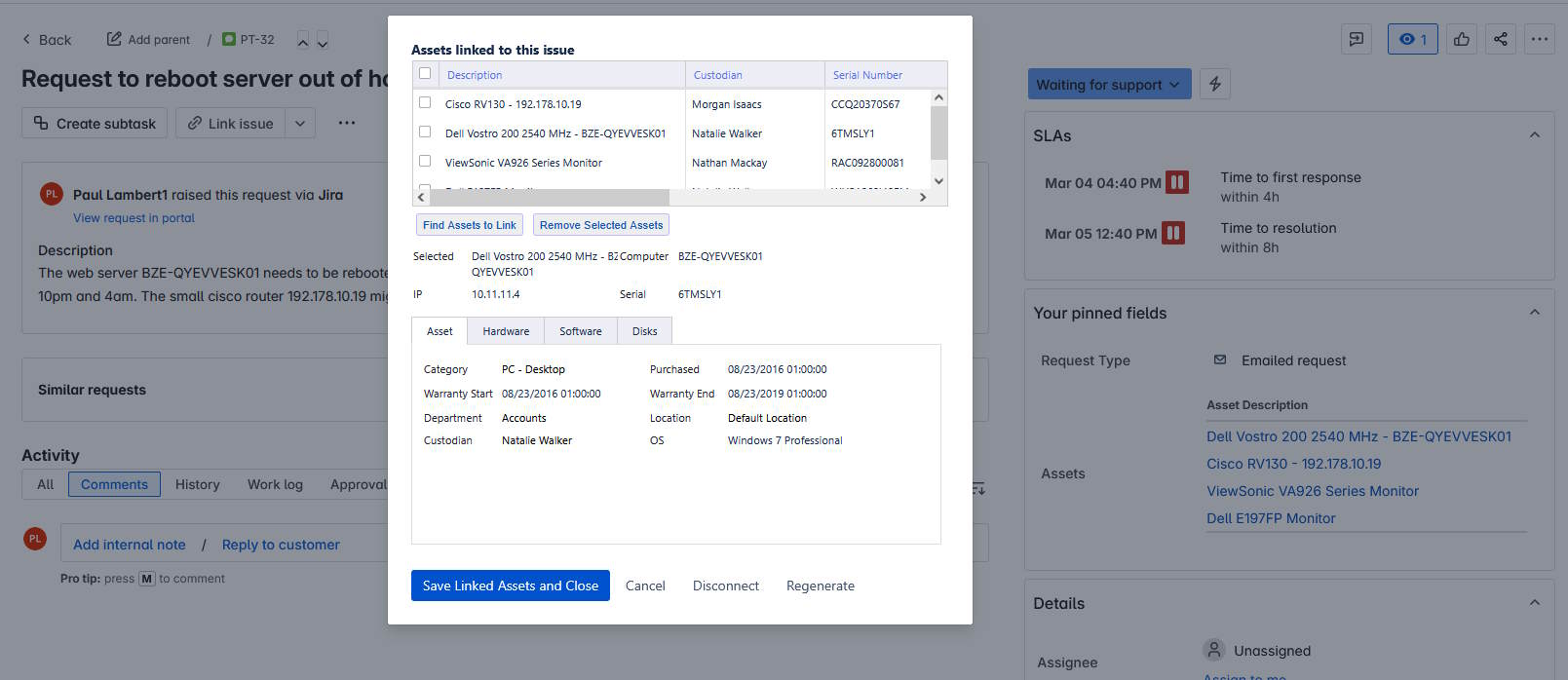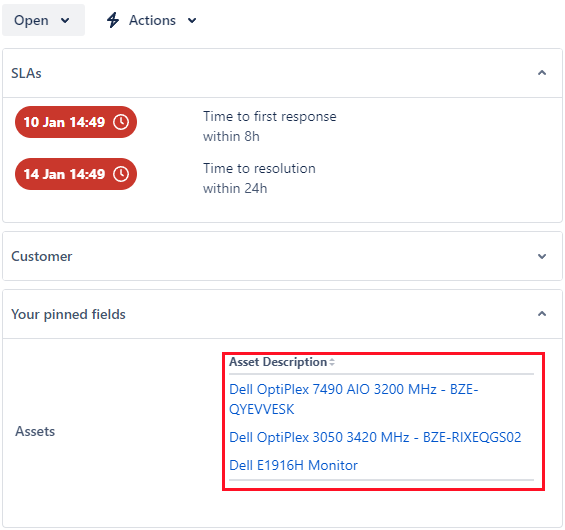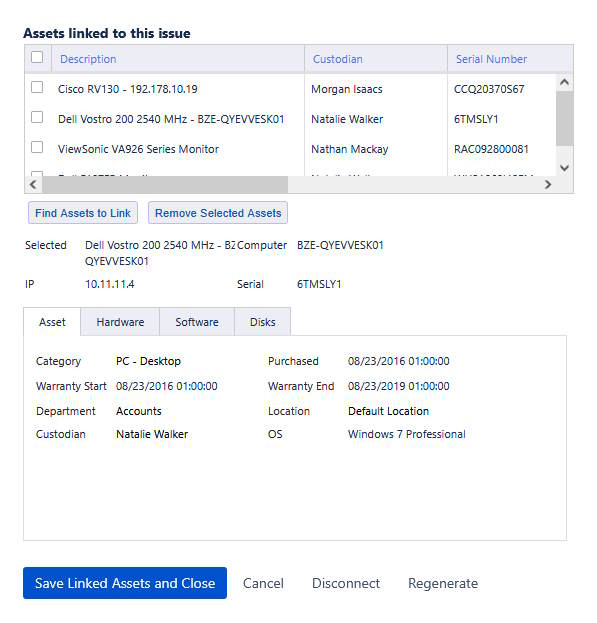USA
800 691 9120
UK
01225 704844
We use cookies on our website to analyze website usage and to help secure the website against misuse. Advertising and functional cookies are not used in our site or our web application products.
By clicking “Accept Essential Cookies Only”, you consent to us placing these cookies.
xAssets JIRA integration allows JIRA tickets to be automatically linked to assets based on ticket content. The assets are then displayed within the JIRA interface.
This provides an alternative to the "Jira Asset Panel" which Atlassian has removed from JIRA. The Atlassian JIRA Asset Management Module is not required to use this integration.
Using our JIRA Integration you can:
xAssets will select the most suitable assets based on the name of the reporter, the summary, and description. If the JIRA issue text contains peoples names, IP addresses or computer names, the system assigns these assets and can prioritize key devices, like the user's laptop.
Users can accept the auto-generated list or they can manually choose other assets. Once saved the list is stored but can be regenerated at any time.
This integration is included in xAssets IT Asset Management software and xAssets Network Discovery software.
IT technicians commonly encounter incomplete or vague tickets. A user reports a problem, but their description is missing important asset details, such as:
“My computer is slow and keeps crashing.”
Without relevant asset information, service desk staff must:
This inefficient process can lead to:
This integration helps solve these problems and increases help desk productivity.

The software analyzes the ticket reporter, the summary, and the description. Any of the following data can be inferred or mentioned in the ticket text:
| Field name | Usage |
|---|---|
| Reporter | The name of the reporter is used automatically and does not need to be mentioned in the ticket text |
| Persons Names | The system links tickets to assets by identifying the user's name and fetching the users associated devices |
| Computer Names | If the ticket mentions a specific computer name, the system automatically matches it to the asset |
| IP Address | If an IP address is mentioned in the ticket, we find and assign the associated device |
A user reports performance issues with two specific devices and includes their computer names in the description:
Issue Description: "Software is not working on computers BZE-QYEVVESK and BZE-RIXEQGS02"

Once the ticket is refreshed, or when the asset panel is clicked, xAssets scans the description for relevant asset identifiers. Instead of requiring manual asset selection, the system gets the computer names (or other asset data) and matches them to records in the linked xAssets database.
In addition to identifying computer names, xAssets AI also scans for people names and IP addresses.
To review the linked assets:

The asset panel is displayed:

Now the dialog box shown above can be used as follows:
The system has matched BZE-QYEVVESK and BZE-RIXEQGS02. The IT technician can now click the asset panel to see each asset and comprehensive details shown in tabs, including:
| General Information | Asset description, Computer Name, User name and Serial Number |
| Classification Data | What kind of asset is it, where is the asset, who uses it, warranty data, and other allocations |
| Hardware | CPU, RAM, motherboard, network adapters |
| Software | Installed applications and licensing details |
| Disks | Disk space, disk size, and disk type (SSD, Removeable, etc) |
Users can remove assets and add other assets. Any asset in the xAssets database can be linked to the incident.
| Aspect | Manual Process | AI-Powered Automation |
|---|---|---|
| Asset Identification | IT staff manually search for asset details | AI detects and assigns assets instantly |
| Ticket Resolution Time | Slower due to manual lookup and verification | Faster with automatic asset matching |
| Error Rate | Higher risk of incorrect asset assignments | Reduced errors with intelligent asset detection |
| Workload | Increased for IT teams due to repetitive tasks | Decreased as AI handles asset identification |
| User Satisfaction | Lower due to longer response times | Higher with quicker and more accurate resolutions |
xAssets flexibility extends beyond automation. The system allows full configurability, so you can control the asset data which is visible to your teams, ensuring they have the insights they need without seeing unnecessary information.
Customization Options Include:
IT admins can configure visibility per role, ensuring that users only see the most relevant data needed - without being overloaded.
As businesses grow, so do their IT environments. The scale and complexity of assets multiply, rendering asset management systems outdated or overwhelmed. With xAssets AI-powered asset detection in JIRA, your organization is equipped with an easy to use, scalable solution that can manage the increasing demands of an expanding business.
As your organization grows, your IT team needs tools that can evolve with it. With xAssets, you're not just adopting a system for today - you're investing in a solution that will continue to serve your needs well into the future. As your IT infrastructure becomes more complex, xAssets will help you manage it with less effort, greater efficiency, and fewer setbacks.
Free instances allow up to 100 endpoints, but Integrations cannot be used. A paid instance can combine Discovery, or Integration to SCCM, Intune, Meraki, MDMs and others
Free instances are free forever and can show demo data or your data.































